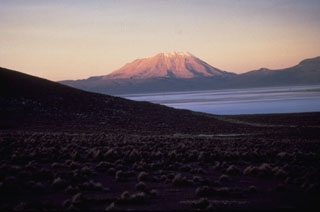Report on Ubinas (Peru) — 18 September-24 September 2019
Smithsonian Institution / US Geological Survey
Weekly Volcanic Activity Report, 18 September-24 September 2019
Managing Editor: Sally Sennert.
Please cite this report as:
Global Volcanism Program, 2019. Report on Ubinas (Peru) (Sennert, S, ed.). Weekly Volcanic Activity Report, 18 September-24 September 2019. Smithsonian Institution and US Geological Survey.
Ubinas
Peru
16.345°S, 70.8972°W; summit elev. 5608 m
All times are local (unless otherwise noted)
During 16-22 September the number of seismic events totaled 4,356, with volcano-tectonic (VT) signals being the most numerous, averaging 567 events per day, and all having magnitudes under M 2.5. Hybrid events averaged 119 events per day. Continuous emissions of blueish gas and water vapor were recorded by the webcam rising to heights less than 1 km above the summit. Four thermal anomalies were recorded by the MIROVA system. The Alert Level remained at Orange (the second highest level on a four-color scale) and the public were warned to stay outside of a 10-km radius.
Geological Summary. The truncated appearance of Ubinas, Perú's most active volcano, is a result of a 1.4-km-wide crater at the summit. It is the northernmost of three young volcanoes located along a regional structural lineament about 50 km behind the main volcanic front. The growth and destruction of Ubinas I was followed by construction of Ubinas II beginning in the mid-Pleistocene. The upper slopes of the andesitic-to-rhyolitic Ubinas II stratovolcano are composed primarily of andesitic and trachyandesitic lava flows and steepen to nearly 45°. The steep-walled, 150-m-deep summit crater contains an ash cone with a 500-m-wide funnel-shaped vent that is 200 m deep. Debris-avalanche deposits from the collapse of the SE flank about 3,700 years ago extend 10 km from the volcano. Widespread Plinian pumice-fall deposits include one from about 1,000 years ago. Holocene lava flows are visible on the flanks, but activity documented since the 16th century has consisted of intermittent minor-to-moderate explosive eruptions.

